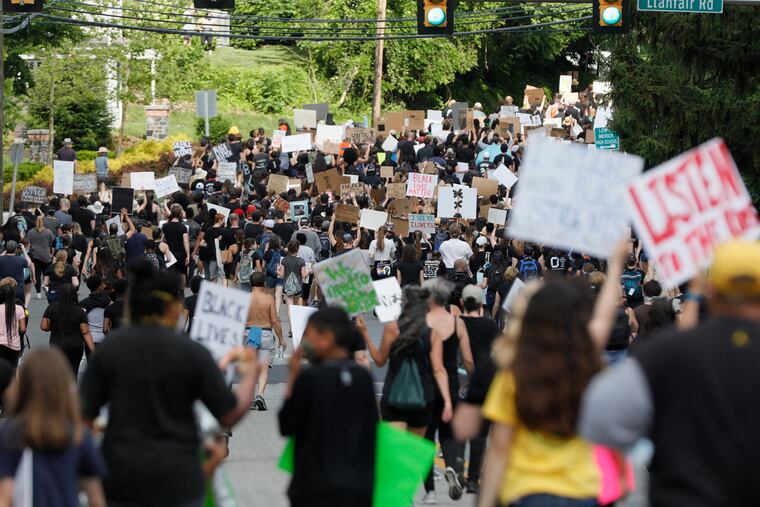How suburban school districts like Lower Merion can show that Black lives matter | Opinion
In 2020, Lower Merion must choose a different path than yet another one-off committee.

Philly’s suburbs heard the call to action from protesters this summer: Defund the police. Invest in communities.
Ardmore was among the myriad Philly suburbs staging local protests. But this rally wasn’t about a lack of community investment or police brutality.
Instead, Ardmore residents described the long history of racism within Lower Merion schools. As a 2014 alumna of Lower Merion High School, I was regrettably unsurprised.
A new Instagram page, @blackmainlinespeaks, corroborated protesters’ accounts. One Black LMHS student reported that: “A boy said that all black people were lazy and poor while looking right at me, the only black person in the class. The teacher applauded him for being smart right after he said that.”
In due fashion, Lower Merion responded to these complaints and the national moment by announcing the formation of a committee on anti-racism. According to the district’s Twitter page, “this AdHoc Committee on Equity and Anti-Racism” will “address racism, safety and security” within Lower Merion schools. The committee pledges to “work proactively to listen to voices in our community, not only to ensure the past inequities are addressed to the extent possible, but to ensure that they are righted for the future.”
What are these inequities? An unspeakable achievement gap between Black and white students, earning Lower Merion and districts like it nationwide concerning or failing ratings under No Child Left Behind. According to the most recent public statistics in 2017, less than 5% of LMHS white students tested below proficient in reading, while over 41% of Black students did. Worse in math: 12% of white students did not reach proficiency, but nearly 66% of Black students did not.
What Lower Merion as a community needs to realize is that they are a failing school district until they close this achievement gap. The impressive college outcomes and test scores of their majority-white student body mean nothing until that gap is closed.
An ad hoc committee on anti-racism is not enough. Lower Merion has tried this multiple times with unsurprisingly dismal results. Since the district was formally desegregated in 1963, Ardmore activists and school officials have made an honest effort. In 1997, LM formed the Committee to Address Race in Education to work on closing the gap, which met limited success. In 2004, LM hired 10 new Black teachers in response to concerns from the Black community. Still no change in the achievement gap data. In 2009, a group of Black families, backed by the Concerned Black Parents of Mainline Inc. and the local NAACP, sued the district for continuing to track their students into remedial classes despite these efforts. The district added another “Achievement Imperative Task Force” in 2016.
In 2020, districts like Lower Merion must choose a different path from a one-off committee. They need to take action.
First, continue to hire more Black teachers throughout the district. A 2018 study showed that having a Black teacher before third grade increases a Black child’s likelihood to attend college by 13%. With two Black teachers, it increases by 36%.
» READ MORE: As a Black student at Haverford College, I know what racism looks like at ‘liberal’ institutions | Opinion
Next, establish a robust mentoring program that helps Black students navigate the Advanced Placement course catalog and various extracurricular activities, instead of funneling them into standard-level classes and the Kobe Bryant-acclaimed basketball program. Existing minority achievement programs at Lower Merion do not provide the critical 1-1 relationships that support young people. This type of mentoring has had promising results for Black students navigating less well-resourced public schools. More recently, the U.S. is recognizing the importance of mentoring and counseling for high school retention and college success, while many districts’ budgets have yet to prioritize these programs. Lower Merion could help set an example.
Finally, create a mandatory mini-course about Lower Merion history that recasts this “urban” problem of school segregation and unequal opportunity to this side of City Line Avenue. Lower Merion must teach its students that inequality and racism are not just problems of the city. Instead, they are systemic issues that white “liberal” suburbanites perpetuate.
This time, Lower Merion must make sure that its response to the national moment isn’t solely symbolic. This time needs to be different nationally and in Lower Merion. If Black Lives Matter on Philadelphia’s streets, they’ve got to matter in suburban classrooms, too.
Rebecca Zimmerman, a 2014 graduate of Lower Merion High School, is a history teacher at the Riverdale Country School in New York City and a graduate student in education at the University of Pennsylvania.